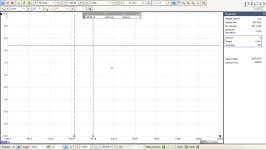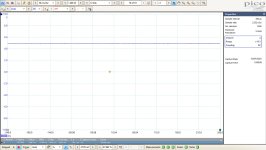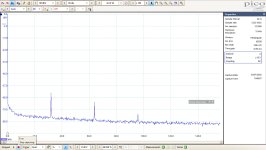The red waveform in IMG_3499.png appears to have a ratio of approximately 67:23 between 0 and 1. This ratio is roughly 3:1, which is close to the upper limit of the amplitude for 1bit DSM with orders of six or higher. Consequently, at high OSR, it may become unstable and potentially undergo internal resets. The output during a reset depends on the algorithm, but it is possible to observe repetitions of 0 and 1. Lowering the input level by about 2dB might restore stability.
First image is the Amanero output in red and the Firdac’s output in blue before the analogue filter.
Second image is a more accuratr image of left and right channel again after the Firdac and before the analogue filter.
One channel is O.K. and the other is showing a spike, this time in negative direction.
Third image shows how a spike looks after being analogue filtered.
Hans
The red trace in your first graph looks like an RTZ signal rather than like the Amanero output signal.
Yes Marcel, of course you are right.
I also just came to the same conclusion.
In my original email to you it was correctly specified.
Hans
I also just came to the same conclusion.
In my original email to you it was correctly specified.
Hans
The DSD-on flag is low whith non DoP bitstreaming.
Thx.
Hans
So all in all, you have an interface board with an ASIO driver that is supposed to have two methods to handle DSD bitstreams, the default ASIO native DSD method and the DoP method. The default method doesn't work at all and the DoP method randomly produces incorrect data at DSD512. 😲
That is to say, incorrect data for one channel only and only for DSD512.
The other channel was not showing anomalies and could be used for S/N measurement without any problems.
Results in S/N for the correct working channel were well below the other DSD rates in my review, making me to suggest that for the Amanero this rate might be too far fetched.
Hans
The other channel was not showing anomalies and could be used for S/N measurement without any problems.
Results in S/N for the correct working channel were well below the other DSD rates in my review, making me to suggest that for the Amanero this rate might be too far fetched.
Hans
The ASIO Native DSD method probably works as far as the Amanero is concerned, unless maybe its somehow broken (maybe it could be re-flashed?). Not clear that J River is able to send Native DSD though?
Aren't we back to substitution: swap out USB board, or swap the DSD player app? One or the other is likely to fix the problem.
Also as I said before, Windows can interfere with ASIO. Its not a foolproof as WASAPI Exclusive Mode. Probably wise to make sure the sound device (the Amanero) has not been selected by Windows to serve as the "Default Sound Device" nor the "Default Communication Device." Its just just something else to check with working with Windows.
I never let my hi-fi sound card have the "green circle with the white check mark inside" as show below. That green circle is bad.

Aren't we back to substitution: swap out USB board, or swap the DSD player app? One or the other is likely to fix the problem.
Also as I said before, Windows can interfere with ASIO. Its not a foolproof as WASAPI Exclusive Mode. Probably wise to make sure the sound device (the Amanero) has not been selected by Windows to serve as the "Default Sound Device" nor the "Default Communication Device." Its just just something else to check with working with Windows.
I never let my hi-fi sound card have the "green circle with the white check mark inside" as show below. That green circle is bad.
Last edited:
In the link Hans provided in post #835, https://wiki.jriver.com/index.php/DSD , it is explained how to use ASIO native DSD mode with JRiver, which suggests it is supposed to work.
Wasapi in this case is limited to DSD128.
Only Asio manages the higher rates.
Since DoP packing is a lossles proces, that’s why I see no reason to assume that a non DoP native DSD would produce a better S/N, if managing to making this working in some way on the Amanero.
And as I mentioned before, an interface board with separate Clock and Data signals over coax lines would probably have resulted in better S/N figures for Marcel’s shiftregister Firdac, indicated by the fact that Marcel achieved a 5dB(A) better result in S/N both using the same .dsf file, but in his case split over separate lines.
Obviously some find it hard to accept that in my review the Amanero doesn’t meet their expectations. That’s why I would welcome anyone else repeating my measurents.
Hans
Only Asio manages the higher rates.
Since DoP packing is a lossles proces, that’s why I see no reason to assume that a non DoP native DSD would produce a better S/N, if managing to making this working in some way on the Amanero.
And as I mentioned before, an interface board with separate Clock and Data signals over coax lines would probably have resulted in better S/N figures for Marcel’s shiftregister Firdac, indicated by the fact that Marcel achieved a 5dB(A) better result in S/N both using the same .dsf file, but in his case split over separate lines.
Obviously some find it hard to accept that in my review the Amanero doesn’t meet their expectations. That’s why I would welcome anyone else repeating my measurents.
Hans
WASAPI does not support any kind of Native DSD. ASIO is used when Native DSD is required. IIUC there is no other real need anymore for ASIO. Problem with DoP is it requires twice the bandwidth of Native DSD to transport data since only half of the DoP data words are used for DSD data. The other half carries PCM codes indicating that DoP is being used. Therefore it is not uncommon to see higher supported DSD sample rates if using ASIO and Native DSD instead of DoP.
Last edited:
Mark, that’s a good point.
When I’m back home, I’ll try Asio without DoP, despite the fact that DSD-on stays low.
Since I don’t have a shift register Firdac anymore, I’ll connect a simple RC network to the Amenero’s output to tell whether it works at all.
For me the case is closed till then.
Hans
When I’m back home, I’ll try Asio without DoP, despite the fact that DSD-on stays low.
Since I don’t have a shift register Firdac anymore, I’ll connect a simple RC network to the Amenero’s output to tell whether it works at all.
For me the case is closed till then.
Hans
This is on the way to you. Boards are the actual ones as tested by Ray with his own listening impression as posted a while ago - so a known good systemBTW since we are talking, are you still of a mind to send one of Marcel's dacs here for listening tests? Or has that fallen by the wayside?
Hi Hans, hope you're enjoying your holiday 🙂. I've been playing around with JRiver and found some things. Did you enble DSD512 in Bitstreaming? Default setting is DSD256 (4x), and must be changed to DSD512.

The second thing is to disable the MC engine, Output format should be deselected.

JRiver can be tried for 30 days, fully functional https://www.jriver.com/download.html
DoP didn't work on my DAC, got hiss only.
Dagfinn
The second thing is to disable the MC engine, Output format should be deselected.
JRiver can be tried for 30 days, fully functional https://www.jriver.com/download.html
DoP didn't work on my DAC, got hiss only.
Dagfinn
Hi Dagfinn,
I think this what you get when using the Topping Asio driver.
With the Amanero Asio driver I haven’t seen this option screen so far, but thx anyhow for the tips.
I’have a full version of JRiver MC30.
Hans
I think this what you get when using the Topping Asio driver.
With the Amanero Asio driver I haven’t seen this option screen so far, but thx anyhow for the tips.
I’have a full version of JRiver MC30.
Hans
Just a reminder that my own listening was with the DAC breadboarded with ordinary LM317-based power supplies so not optimal and probably ripe for improvements. - still very impressed though.This is on the way to you. Boards are the actual ones as tested by Ray with his own listening impression as posted a while ago - so a known good system
Great. Looking forward to hearing it. May take a few days to get it set up with power, clocking, some shielding, etc. Will let you know how its going.This is on the way to you.
That shows that the DAC is well designed and built to start with. For all you know, it may turn out to be like case of diminishing returns for more elaborate schemes. You may want to try out these UltraCap supplies - some safety concerns with these high energy stuff but folks elsewhere reckon it is something to die for🙂Just a reminder that my own listening was with the DAC breadboarded with ordinary LM317-based power supplies so not optimal and probably ripe for improvements. - still very impressed though.
No doubt there are diminishing returns as a system gets closer and closer to ideal. There is always low hanging fruit at first which is relatively cheap and easy to fix.
Questions are what are your performance requirements and or what is your budget? Also, how is a point of diminishing returns defined?
Questions are what are your performance requirements and or what is your budget? Also, how is a point of diminishing returns defined?
Last edited:
Hi Mark,Hi Hans,
I'm sorry. Didn't mean to imply the problem you saw was because of USB power. Hard to say without more testing.
It just seemed to me that the discussion with Acko had moved on to include the use of Amanero more generally.
I was puzzled by the apparent satisfaction with it when powered from USB. IME the same would be true for other USB boards if powered that way.
That said, noise on USB power is likely to be different in every case since it is dependent on the particular computer.
Mark
I measured the 5Volt USB power directly entering the Amanero Combo484.
The recordings where made while playing a DSD512 file, it didn't make any difference what file was played.
First image below is taken at a 50nsec/div almost equaling the 22.579Mhz clock frequency for DSD512, see dotted lines, this image recorded with a 2nsec sample interval, and never a glitch occurs.
Second image shows the same but now for 50msec/div, giving a view over a much longer time.
In this image at the bottom, you can see that the 5volt DC has a noise level of ca.19mV Vrms, suggesting that the Amanero's power converter to 3,3Volt will have enough input voltage at all time.
Last image shows the spectrum at a 16Mhz FFT BW, magnified to show the content up to 160Khz.
There are spectral lines visible at 32Khz, 64Khz and 96Khz, but at a 1mV level and below, most likely from my computers SMPS.
For the test that I performed, this USB supply seems fully adequate IMO.
Hans
Attachments
- Home
- Source & Line
- Digital Line Level
- Return-to-zero shift register FIRDAC


